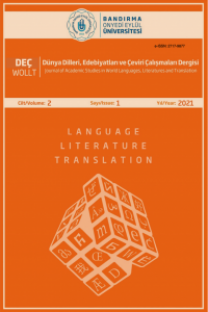Black Swan Filmine Uyarlanan Kuğu Prenses Efsanesine Yeni Bir Yorum: Nina'nın Aynalara Yansıyan İç Çatışmaları
Bu makale uzun yıllardır süregelen Kuğu Prenses efsanesinin karşılaştırmalı edebiyat, film ve medya çalışmaları gibi farklı disiplinlerden gelen bir grup sanatçı tarafından ne şekilde yorumlandığını ve yeniden nasıl üretildiğini paylaşmayı amaçlar. Çavkovski’nin ünlü Kuğu Gölü balesinden ilham alan ünlü Amerikalı yönetmen Darren Aronofsky, filmin senaryosunu 2009 senesinde yayımlayan senaryo yazarları Mark Heyman, Andres Heinz ve John McLaughlin ile yakın bir iş birliği içinde 2011 senesinde Siyah Kuğu filmini çeker. Bu yapıma oyuncuların başarılı performansları da eklenince, film Çaykovski’nin müziğinin ötesine geçen farklı yorumlar ve açılımlar kazanır. Bu yorumlar arasında, bu makale “çift karakterlilik” meselelerini sorunsallaştıran psikanalitik bir yaklaşımı esas alır ve öncelikli olarak Kuğu Prenses efsanesinin genç bir kızın, Nina’nın, tutkulu bir kadına dönüşmeye çabalarken kendisiyle yaşadığı iç çatışmaları nasıl biçimlendirdiğine odaklanır. Çoğunlukla seyircide dehşet uyandırmayı hedefleyen daha önceki yapımlardan farklı olarak, bu çifte görüntü film boyunca aynalardaki yansımalarda, hatta yansıma yapan tüm yüzeylerde, takip edilebilir. Yönetmenin bu görsel tercihi, insanın gerçeği gerçek olmayandan ayırt etmede ne kadar zayıf olduğunu anlamamızı sağlar.
Anahtar Kelimeler:
Kuğu Prenses efsanesi, yeniden yorumlama, psikanalitik yaklaşım, çift karakterlilik, yansımalar
New Taste in the Myth of Swan Queen in the Film Black Swan: The Inner Conflict of Nina Reflected in the Mirrors
This paper aims to share how the long-lived myth of the Swan Queen has been interpreted and reproduced by a group of artists from different disciplines including comparative literature, film, and media studies. Inspired by Tchaikovsky’s well-known Swan Lake ballet, Darren Aronofsky, who is a well-known American film director, creates the film entitled Black Swan in 2011 in close cooperation with the screenplay writers, Mark Heyman, Andres Heinz, and John McLaughlin, who jointly published the script in 2009. Once the outstanding performance of the cast is added to this creation, the whole film extends itself to different interpretations and insights along with Tchaikovsky’s music. Among so many of them, this paper primarily focuses on how this myth of the Swan Queen shapes the inner conflict of a young girl who tries to become a passionate and womanly being from a psychoanalytic perspective that problematizes the issues of the “double”. Different from the previous productions which mostly intend to evoke horror, this double image can be followed throughout the film through the reflections in the mirrors, at any rate on any reflective surfaces and this enables us to see how fragile a human being is to differentiate the real from the surreal.
Keywords:
the myth of the Swan Queen, reinterpretation, psychoanalytic approach, double, reflections,
___
- Aronofsky, D. [Director]. (2010). Black Swan [Film]. Los Angeles, California, United States: Fox Searchlight Pictures.
- West‐Leuer, B. (2017). Black Swan – the Sacrifice of a Prima Ballerina: Psychosexual (Self‐)injuries as the Legacy of Archaic Experiences of Violence. The International Journal of Psychoanalysis, 98(4), 1233-1244. DOI: 10.1111/1745-8315.12658.
- (n.d.). Black Swan Theory: A Freudian Psychoanalytic Perspective. Studocu. Retrieved February 15, 2023, from https://www.studocu.com/id/document/universitas-negeri-surabaya/extrinsic-approaches-to-literature/black-swan-theory-a-freudian-psychoanalytic-perspective/45819280.
- Freud, S. (1997). The Interpretation of Dreams. Wordsworth Editions: Hertfordshire.
- Heyman, M., Heinz, A., & McLaughlin, J. (2009). Black Swan Shooting Draft. New York City, New York, United States: Protozoa Pictures. Retrieved February 15, 2023, from https://thescriptlab.com/script/black-swan-draft/attachment/black-swan-pdf-2/
- Lacan, J. (2006). Ecrits. “The Mirror Stage as Formative of the / Function as Revealed in Psychoanalytic Experience "1st ed. [ebook]. pp. 93-100. Retrieved May 17, 2023, from http://users.clas.ufl.edu/burt/deconstructionandnewmediatheory/Lacanecrits.pdf .
- Laine, T. (2015). Bodies in pain: Emotion and the cinema of Darren Aronofsky. Berghahn Books, Incorporated: Oxford.
- Mambrol, N. (2016, April 22). Lacan’s Concept of Mirror Stage. Literary Theory and Criticism. Retrieved February 15, 2023, from https://literariness.org/2016/04/22/lacans-concept-of-mirror-stage/.
- Marston, K. (2015). The Tragic Ballerina's Shadow Self: Troubling the Political Economy of Melancholy in Black Swan. Quarterly Review of Film and Video, 32(8), 695-711. DOI: 10.1080/10509208.2015.1060825. Sexeny, J.
- Milly, J. (2011, February 22). Podcast: Andres Heinz Talks Black Swan. Script. Retrieved February 13, 2023, from https://scriptmag.com/features/podcast-andres-heinz-talks-black-swan.
- Plato. (2017). The Allegory of the Cave (Benjamin Jowett, Trans.). In Book VII of the Republic. Enhanced Media Publishing (Original work published in 375 BCE).
- Fox Searchlight Pictures. (2020, October 11). Black Swan (2010): Making of a Masterpiece/ Darren Aronofsky [Video]. Retrieved February 15, 2023, from YouTube, https://www.youtube.com/watch?v=_BSZymoCUsU.
- Yayın Aralığı: Yılda 2 Sayı
- Başlangıç: 2020
- Yayıncı: Bandırma Onyedi Eylül Üniversitesi
